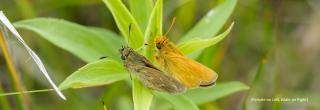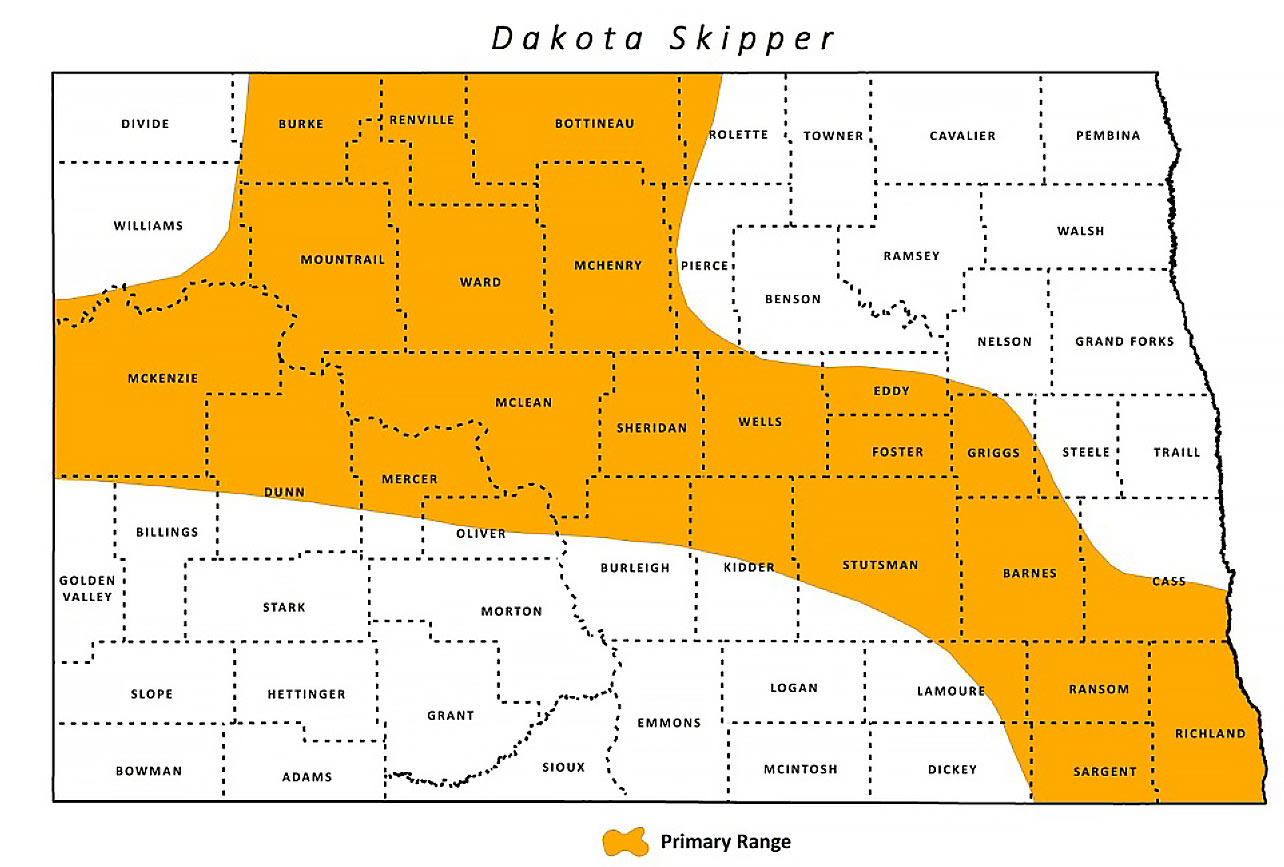
Dakota Skipper
Scientific Name | Hesperia dacotae |
|---|---|
General Description | Small nondescript butterfly. Ventral wing ranges from a golden color in males to a darker brown in females with some light markings. Can be confused with the Ottoe skipper in which it shares habitat preferences. |
Status | Resident. |
Abundance | Rare. |
Primary Habitat | Found in native tracts of tall and mixed grass prairie. Bluestem is indicative of the habitat. Purple Cone flower is often found in these sites as well. |
Federal Status | Threatened |
Reason for Designation | Listed as Threatened by the USFWS. Loss of habitat is the driving concern. |
Locations and Conditions of Key Habitat
Preferred Habitat
Dakota Skippers are found in two types of prairie habitat. The first is moist areas dominated by bluestem grass species with three wildflower species indicative of the habitat, wood lily (Lilium philadelphicum), harebell (Campanula rotundifolia) and smooth camas (Zygadenus elegans). The second type is mesic upland prairie found often on ridges and hillsides. Bluestem grasses and needlegrasses dominate these prairies; purple coneflower (Echinacea angustifolia) is typical found at these sites.
Key Areas and Conditions for Dakota Skippers in North Dakota
Dakota Skipper have been documented in McKenzie, Dunn, Oliver, Mountrail, Ward, Burke, McHenry, Bottineau, Rolette, Wells, Eddy, Griggs, Stutsman, Barnes, Ransom, Sargent, Richland counties in North Dakota.
Problems Which May Affect this Species
Habitat
The loss of native prairie is the primary cause for this species decline. Dakota Skipper are also absent from native grasslands that are intensely grazed or often burned. Lack of management to suitable sites which allows encroachment of invasive species is also a problem. This species does not have the ability to move great distance so suitable sites may be absent of Dakota Skipper from lack of immigration from other populations.
Other Natural or Manmade Factors
The use of herbicide for weed control at certain times of the year innative prairie tracts may be a detriment by reducing nectar sources for the butterfly. Insecticide use near populations may also a factor.
Research and Survey Efforts
Current Research or Surveys
- The USFWS will continue to monitor known sites in North Dakota.
Previous Research or Surveys
- A Conservation Status was developed by Royer and Marrone for North Dakota and South Dakota in 1992.
- USFS surveyed butterfly fauna in the McKenzie Ranger district in 2002, 2003, 2004, and 2010.
- USFWS conducted surveys of McHenry Co in 1998.
- Royer conducted field survey and habitat assessments for 29 sites in ND for Dakota Skipper and Poweshiek Skipperling in 2012.
Additional Research or Surveys Needed
- Training of additional biologists to identify and survey prairie butterflies is needed.
- Development of a protocol to monitor NDGFD managed sites.
Management Recommendations
- Develop pollinator habitat.
- Protect and manage high quality native prairie.
- When using prescribed fire to manage do not burn entire areaof know population. Use techniques to promote patchy burns.Burn prior to May 1 when possible.
- Delay haying of habitat until after end of adult flight. Leave 8 inches of structure to provide over-winteringcover. Do not hay entire occupied site each season when possible.
- Limit the duration and intensity of grazing in Dakota Skipper habitat. Do not graze habitat for entire seasonand manage for 8 inches of structure. Spring grazing is preferable. Avoid grazing of nectar sources during theflight period.
- Avoid broadcast spraying of pesticides and herbicides at known sites to minimize loss of adults and nectarsources.
- Monitor known inhabited sites.
Monitoring Plans
The North Dakota Game and Fish Department currently does not have a monitoring protocol for this species. Currently the Dakota Skipper is not known to occur on NDGFD managed lands. Should they be found, development of a protocol to monitor NDGFD managed lands would be necessary.
2005-2015 PROGRESS
The Dakota Skipper was added as a Level II Species of Conservation Priority during the 2015 Wildlife Action Plan revision. A new SWG proposed with the University of North Dakota will look to develop a model to predict habitat suitable for this and other prairie obligate butterflies.

For more information on the Dakota skipper, visit the USFWS website.
Note: A listing of works consulted when compiling the information on this page may be found in the 2015 State Wildlife Action Plan.
